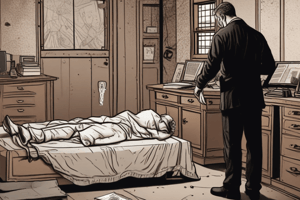Podcast
Questions and Answers
What is the first priority for a responding officer at a crime scene?
What is the first priority for a responding officer at a crime scene?
- Secure, protect, and preserve the scene (correct)
- Arrest the suspect
- Search for and document physical evidence
- Provide medical assistance to the injured
What is the primary reason for protecting and securing the crime scene?
What is the primary reason for protecting and securing the crime scene?
- To ensure the safety of the officers and witnesses
- To ensure the arrest of the suspect
- To gather as much evidence as possible
- To prevent the contamination of physical evidence (correct)
What is the role of the first responding officer in the prosecution process?
What is the role of the first responding officer in the prosecution process?
- They are responsible for investigating the entire case
- They are only responsible for arresting the suspect
- They are only responsible for securing the scene
- They are an integral part of the prosecution process until the case is resolved (correct)
What information does the dispatch operator typically provide to the responding officer?
What information does the dispatch operator typically provide to the responding officer?
What is the purpose of considering key questions while driving to the scene?
What is the purpose of considering key questions while driving to the scene?
What is the term for objects obtained by the defendant as a result of committing a crime?
What is the term for objects obtained by the defendant as a result of committing a crime?
What is the primary responsibility of the first responding officer upon arriving at the scene?
What is the primary responsibility of the first responding officer upon arriving at the scene?
Which of the following is an example of an instrumentality of a crime?
Which of the following is an example of an instrumentality of a crime?
When does the responsibility of protecting and securing the scene end?
When does the responsibility of protecting and securing the scene end?
What is the purpose of admissibility of evidence?
What is the purpose of admissibility of evidence?
What is the term for the doctrine that holds that the court may exclude evidence from trial if the officer obtained it illegally?
What is the term for the doctrine that holds that the court may exclude evidence from trial if the officer obtained it illegally?
What is the purpose of documenting the initial investigative steps taken at the scene?
What is the purpose of documenting the initial investigative steps taken at the scene?
What is the term for property that is illegal for a person to possess based on statute, ordinance, or rule?
What is the term for property that is illegal for a person to possess based on statute, ordinance, or rule?
What is the term for anything written or printed that is offered to prove or disprove facts pertaining to the case?
What is the term for anything written or printed that is offered to prove or disprove facts pertaining to the case?
What is a factor that affects the admissibility of evidence?
What is a factor that affects the admissibility of evidence?
What is the purpose of the legal requirement for admissibility of evidence?
What is the purpose of the legal requirement for admissibility of evidence?
What should you do if the judge sustains an objection?
What should you do if the judge sustains an objection?
What type of question requires you to make a decision on an issue?
What type of question requires you to make a decision on an issue?
Why might an attorney ask an irrelevant question?
Why might an attorney ask an irrelevant question?
What is the goal of a defense attorney who asks a confrontational question?
What is the goal of a defense attorney who asks a confrontational question?
What should you do if you are unsure about how to answer a question?
What should you do if you are unsure about how to answer a question?
What is the best way to respond to a question that is designed to make you appear inept or unreliable?
What is the best way to respond to a question that is designed to make you appear inept or unreliable?
What should you do if the judge overrules an objection?
What should you do if the judge overrules an objection?
What type of question goes beyond the proper scope of questioning?
What type of question goes beyond the proper scope of questioning?
What is the primary purpose of elimination prints in fingerprint analysis?
What is the primary purpose of elimination prints in fingerprint analysis?
What should you do to avoid trapping air bubbles under the lifting tape?
What should you do to avoid trapping air bubbles under the lifting tape?
When lifting the lifting tape containing the developed prints, what should you avoid doing?
When lifting the lifting tape containing the developed prints, what should you avoid doing?
What information should be recorded on the back of the fingerprint print card?
What information should be recorded on the back of the fingerprint print card?
What is the primary purpose of collecting latent prints from a crime scene?
What is the primary purpose of collecting latent prints from a crime scene?
When handling a firearm or ammunition at a crime scene, what should you do to avoid contaminating the evidence?
When handling a firearm or ammunition at a crime scene, what should you do to avoid contaminating the evidence?
What should you do when placing the lifting tape on the fingerprint card?
What should you do when placing the lifting tape on the fingerprint card?
What should you do with the latent print card evidence after collecting and processing it?
What should you do with the latent print card evidence after collecting and processing it?
What is the primary purpose of a pretrial meeting?
What is the primary purpose of a pretrial meeting?
What should an officer do if they identify weaknesses in the case?
What should an officer do if they identify weaknesses in the case?
What is an officer's continuing obligation in a case?
What is an officer's continuing obligation in a case?
Why should an officer review all available case documentation before a pretrial meeting?
Why should an officer review all available case documentation before a pretrial meeting?
What should an officer do if they find errors in the documentation of evidence?
What should an officer do if they find errors in the documentation of evidence?
What should an officer do when discussing the case with the prosecutor?
What should an officer do when discussing the case with the prosecutor?
Why should an officer identify any special issues or situations in a case?
Why should an officer identify any special issues or situations in a case?
Who should an officer discuss the case with before a pretrial meeting?
Who should an officer discuss the case with before a pretrial meeting?
Flashcards are hidden until you start studying
Study Notes
Physical Evidence
- Physical evidence can be classified into three categories: fruits of a crime, instrumentalities of a crime, and contraband.
- Fruits of a crime are the objects obtained by the defendant as a result of committing the crime.
- Instrumentalities are the items used by the defendant to commit the crime.
- Contraband is any property that is illegal for a person to possess based on statute, ordinance, or rule.
Admissibility of Evidence
- Admissibility of evidence refers to the legal requirements that must be met before a jury can see or hear about the evidence.
- The evidence must be deemed relevant and real.
- The evidence must be obtained legally and preserved properly.
- The evidence cannot be unfairly prejudicial, confusing, or based on hearsay.
- The fruit of the poisonous tree doctrine holds that the court may exclude evidence from trial if the officer obtained it illegally.
Responding to a Crime Scene
- When responding to a crime scene, the officer's first priority is to secure, protect, and preserve the scene to avoid contaminating any evidence.
- The officer's second priority is to search for, identify, document, collect, and maintain the physical evidence.
- The officer should consider key questions to help assess the situation adequately, such as:
- What is the location?
- Are any weapons involved?
- Has the complainant indicated the suspect's location?
- How many individuals are involved?
- How many officers are necessary to safely contain or control the situation?
- Do you need additional services?
- Do you need special equipment?
- Are any special concerns or dangers associated with the call?
Collecting Latent Prints
- To collect latent prints, the officer should use lifting tape and follow a specific procedure to avoid damaging the print.
- The officer should record the date, case number, location, and other relevant information on the back of the fingerprint print card.
Elimination Prints
- Elimination prints allow fingerprint analysts to distinguish between prints belonging to victims, witnesses, or suspects.
- The officer should take fingerprints from anyone who may have been at the crime scene to eliminate their prints from the pool of suspects.
Firearms Evidence
- When recovering a firearm or ammunition at a crime scene, the officer should follow agency policies and procedures for handling such evidence.
- The officer should apply PPE to avoid contaminating the firearm or ammunition with their fingerprints and DNA.
Pretrial Meeting
- Before a pretrial meeting, the officer should thoroughly review all available case documentation.
- The officer should discuss the case with the appropriate agency personnel, such as their supervisor, watch commander, or crime scene and evidence personnel.
- The officer should be prepared to discuss who, what, when, where, how, and why facts of the case, as well as all evidence and other relevant information.
Cross-Examination Tactics
- During a criminal trial, attorneys may use various tactics to discredit, misrepresent, or confuse the officer.
- The officer should be aware of these tactics and go into court with basic techniques to overcome them.
- The officer should convey professionalism, knowledge, and confidence and give firm, decisive answers.
- The officer should not be confrontational or argumentative, and should remain calm and composed under cross-examination.
Studying That Suits You
Use AI to generate personalized quizzes and flashcards to suit your learning preferences.




